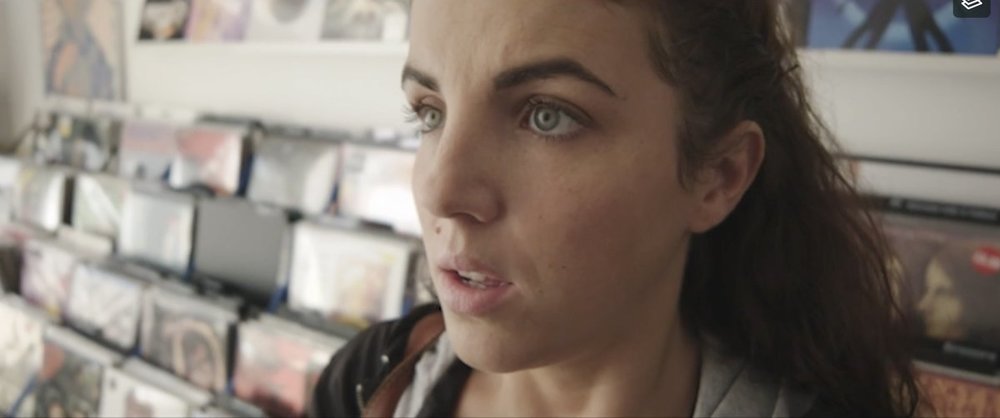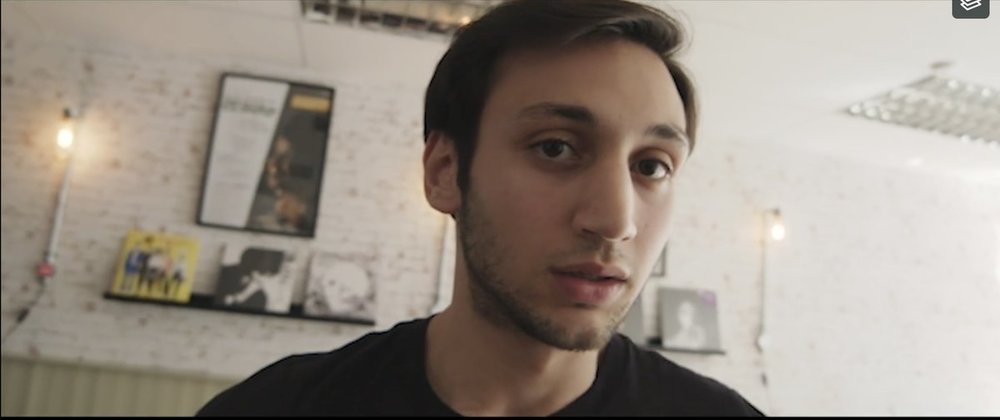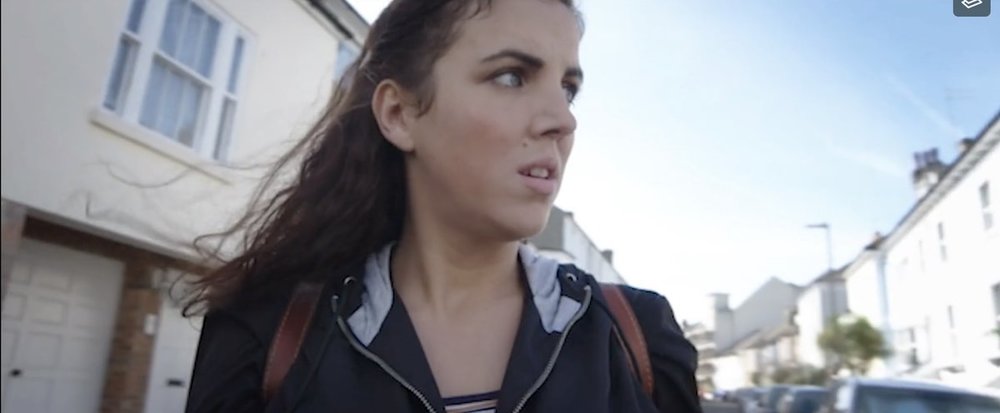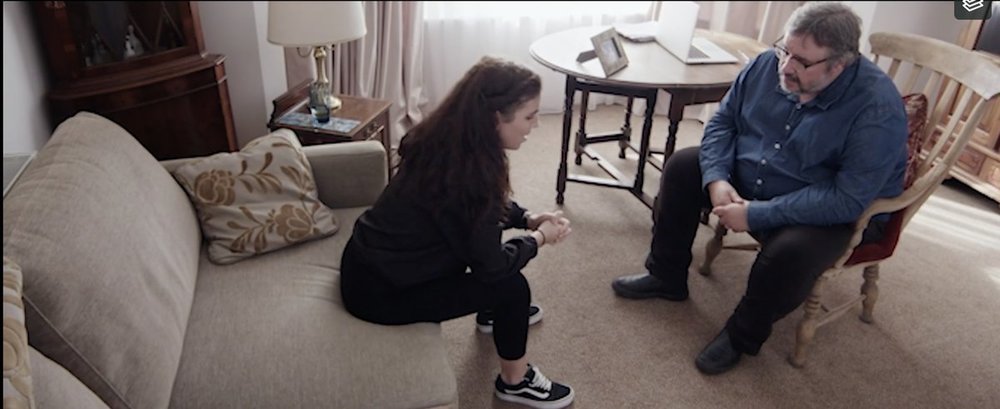-
Posts
1,078 -
Joined
-
Last visited
Everything posted by Phil Connolly
-
The problem with parental advisory notes on IMDB, BBFC etc... is they rob the situation of context. Perhaps making things seem more gratuitous then they are. Of course films are sometimes over weighted to appeal to the male gaze and it serves no more purpose then appealing to that viewership, but at times and places it can serve valid character/story point.
-
Thanks, we found ourselve the Xeen 14mm on my short (The Fruit Fix) last year quite a lot even on closeups. Our next widest lens was a 24mm and that was bit tight for some locations in 2.39:1 (FS7) Here's a couple of frame grabs of closer shots on the 14mm, there's some distortion but it works in context of the sequence (Dop was Tom Shawcroft) The softness is more due these grabs coming off 720p proxies rather then the lenses themselves
-

4:3 Alexa Plus for a Lone Owner/Op
Phil Connolly replied to M Joel W's topic in Camera Operating & Gear
If the new 4K S35 Alexa is really good, maybe the OG mini prices will tank sooner than 5 years. People like the latest and greatest so prices should move when it comes out. -
Different brands lenses will look very different e.g the 14mm Xeen is quite distorted but the 14mm Canon CNE has no distortion its rectilinear. And to be be honest even the distortion on the Xeen is not that objectionable unless you push it into a close up. For instance this is 14mm: Location choice is a factor and that might be regional thing... In the UK/urban areas houses certainly can be small, needing lenses in the 14 to 18mm range for 2.39:1 framed films. If you have a nice big open plan house then lens in the 20 to 28mm work for the wides.
-
In terms of finance there are certainly potential employment and taxation rules that you should follow when staging an international production with an international crew. On a low/no budget indie - working with volunteers on a collaborative project could be a way to side step some red tape. Making a film in Canada with friend's potentially working for free, is not going to trigger the Feds. Of course i would never recommend that people aren't paid for their work or tax is dodged (but i'm aware it happens). Whatever you do make sure you have sufficient insurance cover, particularly important for cross border work. Festivals themselves don't care what you did or didn't pay the cast and crew - thousands of films made with unpaid cast and crew have been screened in festivals. If you pay your cast and crew cash off books (which we know is naughty), festivals aren't going to audit your books and they don't care. What they do care about is they can show the film without getting sued, so the will want to know all the actor, location and music release forms are in place. E.g you own the rights to the performances in the production. Actors/contributors can of course sign a release even if money doesn't change hands and that would be enough for most festivals. Festivals typically don't ask to see all these release forms (imagine the paperwork)- but you will be asked to sign a form to indemnify that you have them and if any problems come out of the woodwork they are your problems not the festivals. In terms of location of production as you say it can get a bit messy when its crew from one place, money from another and shot somewhere else. You could just list the 1 or 2 key areas and make it an international production. E.g the 1 or 2 places most of the work happened. Country of origin matters for festivals and competitions because they often have different categories that are open to different films depending where it came from. It's a benefit to have a film from 2 countries e.g USA and CAN - because then you probably could submit to both USA competitions and CAN competitions... double the chances. Different festivals and comps will have different rules about where they draw the boundary, but you can always talk to them first to check eligibility most are helpful. I was able to submit a film into a regional competition because the director was from the region even though 100% of the production + crew happened elsewhere. I just called the festival explained the films background and they told me it was fine to submit...so you can always check. In the Academy Award example for Armour - (as I understand it) countries can only put forward one feature for consideration for the best international film. So if France had already picked a film to submit and it wasn't Armour, then it couldn't also be submitted as a "French" film. No doubt the production company played up its Austrian credits, to give it a chance by submitting as an Austrian film. Rules are stretched all the time earlier this year "Bait" won the Bafta for "outstanding debut" - yet its not Mark Jenkins first feature, just the first one that got wider notice.
-
While there certainly are Tax issues relating to hiring international staff onto a US production. I doubt its something a festival would audit. A festival only wants to know that you hold the rights to the film for screening purposes and have actor/music/location permits covering the use of them. Often they don't even check you have them, just that you will indemnify (e.g take the hit) in the event of the film being screened without the releases. The simplest way of dealing with the Tax front is perhaps having the actors work on a "voluntary" basis which is perhaps a legal grey area but not something any festival would worry about. A festival does not care how or if you paid your cast/crew, they only want to know you have the rights to the performance...actors can certainly sign a release form without money changing hands. In terms of country of origin, again that's your call - For the purposes of the festival you make a judgment - normally its the location of the production office/where the bulk team is based. Or you could use Canada as the co-production location. It might be useful to have two countries of origin - then it might be eligible for more festivals/competitions. E.g you could submit to USA only catagories and Canada only catagories and sometimes festival fee's are different depending where the film is made. Then you can just submit to the category that's cheaper (if your worried - talk to the festival direct and they will advise you) Again festivals have their own individual rules on this and you can always talk to them. I once got a short in a specific festival because of the city the director was from, even though the production happened in the wrong place - I just emailed them told them who was involved with the production, where they were from and asked if we qualified - if they like the film they will be flexible on origins.
-
I'd imagine the challenge of rigging the mirror to get the angle required while keeping it clean and not getting unwanted elements in shot would be tricky. The visual gain in look - may well be offset by the effort needed to achieve it. For instance if shot doesn't quiet work on the day, it's going to be more difficult to adjust it on the fly. Maybe think of other ways to make your location work for you, deep(er) focus can also be achieved in other. Or if you are jumping through this many hoops to try and make a location work, maybe just get a better location. Sometimes you can get creative tunnel vision once you get locked into a location, where the best option might to take a step back and really think if its best place to realise the scene.
-

Nosferatu (1922) - superimposition
Phil Connolly replied to Marta Teixeira P. Simoes's topic in Visual Effects Cinematography
Depends if your camera allows backwinding. I would say do it in post- then you have control over densities and timings. Nailing it in camera is potentially going to burn through more stock.. Also in camera I'm assuming you'd attempt to do the dissolve by adjusting the Iris - if your camera iris doesn't fully close it's going to be impossible to do a smooth fade without it getting lumpy at the end. As the silent era proved its possible to impressive in camera effects, but if you can better looking results in post faster and with fewer mistakes..i'd always advise that. Unless your desire to do it in camera is part of the process you want to experiment with and the potential flaws to become part of the look. -
Close mic, dry, quiet location. Maybe some compression - but compressors bring up the background noise. Didn't sound very noise gated - or expanded
-
Hi Wendy that would work (in terms it would cut the light) - but the issue is its quiet a specialist skill to get it installed without air bubbles etc... I had a 4 m square area of windows tinted with that film in my house - it was fairly expensive.. took a team of 2 workers all morning to install. Had I had attempted the installation myself I'd have most likely made a mess of it and in the long term it would cost more money to buy more materials and and expert to fix. Much like the time I tried to replaster the bathroom... 1 hour to skim... 3 additional days to sand the wall back to flat... Not really practical on a film set. It would also be quite a job to remove. Normal ND gel rolls can sometimes be rigged quickly if you hang them outside the window - if its not windy and the area is out of focus they don't need to be perfectly cut to match the window. Personally - NDing windows seems to be thing that happens less these days ... in the MiniDVcam days - I had to gel every window for pretty much any shot just to be in with a fighting chance. Now cameras have a 14stop range and you've got cooler running LED's - is easier to balance the light in a scene without reaching for the ND as often. Plus in the UK is not often that sunny
-
I don't think cardboard would work - it would absorb low frequencies. What about making one from Fibre Glass? You can get kits for boat repairs etc... Then you could make any size you want and it would probably be easy to source a former to make the shape - a Yoga exercise ball or similar could work.
-
One general note I'd give if your attempting to get into festivals is the film is a little bit long. Short films below 15 mins have a better chance of being programmed. That's because festivals would usually prefer to screen 2 x 10 min films then 1 x 20 min. Of course if you film has to be the length it is because that's how long the story is... that's also fine, there are lots of good 20-30 min shorts. In this case, I think you could get it down to 15 mins without losing too much. The intro title sequence on the film doesn't add much, with shorts it's important to get on with story. Although the shots of the cardboard houses/insect looks cool - it delays the start of the story. Setting a mood is ok - but on this it felt a little over long. waiting 3 mins to start the story on a short risks losing your audience. Same with the cool tunnel. The walk in looks like "hey we found a cool tunnel, let's show it off" rather than a particular narrative point that could be served by a shorter entrance. Serve the story not the location. If anything the location choice could be considered to work against the narrative, is that the best place to conduct a deal? It's exposed, would a dealer leave their car to walk down a long tunnel? etc...
-
But basically you have to deliver in a standard format either 1080 across for HD or 2048 across for 2K. If your camera is 1080p and your shooting with anamorphics with the intention of cropping to 2.39:1 your original footage is sub HD anyway. When you stretch your footage out you don't gain resolution. 2048 pixels across would be quite a bit higher than the actual resolution of your rushes - so your not loosing anything by making a 2k master
-

White Balance in Digital Cinematography
Phil Connolly replied to Max Moosbrugger's topic in General Discussion
Also, you might not want a neutral look. White balancing a camera brings the whites to neutral. But you might want the scene to play a little warmer or colder than neutral - so you use a preset to dial in the look you like or leave the camera set and adjust the lighting. Sure you can also make those changes in post - but recording in a "look" means the rushes are going to look how you want them throughout the edit. Rather than recording everything neutral and hoping the colourist will grade to match your intentions. I shot a short years ago using daylight lamps and a 3200k white balance - so it was intentionally very "blue" - sure we could have done that in post - but sometimes there is some merit to committing to a look. (had we shot more neutral, I suspect we'd have chickened out in colour correction and not gone as far) This was in DV days where do didn't have as much latitude in post, you had to basically nail the look in camera. -

Film Discussion: How Essential Is Establishing Shot?
Phil Connolly replied to Max Field's topic in Directors and Directing
"Establishing Shots" - do have a lot of use in the edit. Sometimes you need a beat between one scene and the next. Sometimes you only discover the issue mid edit, e.g the transition you planned doesn't work - but you need some "filler" to join the two scenes or space them out because you need to give the audience time to digest the end of one scene before the next begins. Establishing shots work well because if you don't have the footage it's easy to go out and shoot some pickups or use stock footage (in a covid pinch). E.g a quick house EXT that doesn't need the actors. It's not about cinematic perfection but making the edit flow better. As David states it's better if these are scripted and planned for. But on a shoot day it's often the first thing you drop when you are behind (because it can be picked up later). -

Using a Samsung tablet for nature audio recording
Phil Connolly replied to Patrick Cooper's topic in Sound
Most condenser mics need external phantom power, dynamic mics don't need external power. Condenser mics are typically more sensitive, so better for recording atmospherics. USB mics usually take their power from the USB port. On the budget end, a Rode Smartlav+, is a small omi lapel mic for Phone/tablet use that could be adapted to your purposes. If you use a 3.5mm connection for your mic, maybe it's possible to use Bluetooth wireless headphones for monitoring. But to be honest it's a bit of cludge to jerry rig audio recording on a tablet, for anything more then the most basic purposes. Once you start spending on XLR and phantom power adapters - it's probably easier and cheaper to just get a dedicated field recorder. You could probably pick up a secondhand Zoom, Tascam, Merantz or similar field recorder on ebay for around $100 if your patient. -

Using a Samsung tablet for nature audio recording
Phil Connolly replied to Patrick Cooper's topic in Sound
USB Microphone? -

Key light - what power for 5m square room?
Phil Connolly replied to Ben Edgar's topic in Lighting for Film & Video
As others have said the big soft source might be expensive to do and you also don't have that much space to rig it. It your situation maybe a more DIY approach would work - especially if you go for a night time look. You could get a few practical "lamps" e.g desk lamps, ikea uplighters, things with lamp shades.. These will allow you to create pools of light and hotspots that give texture to the image. Then either a couple of small LED's or tungstens could be used for Ke. If money is tight a 500W halogen worklight from B and Q bounced on poly would do the job. E,g this vide works nicely - because there are quite a few practical lights in the studio giving it some texture: Looks like they just had a couple of small LED's to augment the available light. On a low budget it's easier to do dark and contrasty then bright, soft and sunny. That way in a small space you don't need huge lights if you don't mind a high contrast look. The biggest light in the below video was a 650w tungsten fresnel - back lighting to double bass. Actually more than enough light, probably too much -
Basically the "tape sound" is mostly about recording signals as loud as you can and risking a bit of natural distortion/compression in the process. If you don't record loud enough your recording can get buried in the noise floor. Distortion and compression sound better then tape hiss. Digital recordings don't have much background noise (e.g hiss) so you don't need to record as loud mainly because digitals response to signals that are too loud, is to clip - which sounds horrible. Digital is more accurate, analogue tape colours the sound to a lesser or greater degree depending on the techniques used. Also how you watch the film will colour the sound.. when you listen to a film with a fully digital sound track your hearing what occured in the studio - with frequencies from 20hz to 20khz. But film prints with optical audio don't have any frequencies above about 10 to 12Khz, which colours the sound a lot. But also can sound nice and warm and less harsh then digital. NPR run all their radio shows through a 12khz low pass filter for the "NPR sound" which is smoother. Sometimes movies in analogue sound better. For instance take any recent Chris Nolan film played back at reference level - its going to be crazy loud, harsh sounding and give you a headache - at that point a nice gentle optical track sounds like a good option
-
I think a lot of the sound is due to needing to work a bit harder to get over the "noise floor" of tape. Good recording practice in that situation is to record signals as hot a possible and use limiters/compressors a little more to control peaks. The result would sound a little "fatter" with some harmonic distortion and compression artifacts. Also with an analogue workflow your going to be bouncing audio down multiple generations - so you want a beefy recording to survive the process. Same with foley mics maybe you'd be inclined to mic a little closer to overcome noise and result in a bit of proximity effect which boosts low frequencies... At the tail end of the 70s and through into the 80s you had noise reduction coming in A type and SR which drops the noise floor and I imagine sounds didn't quite need to be recorded so "hot". 80s films can sound a little more open and natural compared to 60s, 70s (thanks to Dolby). SR in particular drops the noise floor by around 26db's allowing 15ips tape to match or ecceed CD's for noise floor Then once digital happened you have both the low noise floor and the ability to dub and bounce without too much loss, you don't need to record signals as loud, so that sounds different. Clipping in digital sounds horrible so good practice is leave lots of headroom. On analogue gear your typically hitting the tape much harder and trading distortion for noise. (also subtle tape distortion can sound good) To replicate the sound either try bouncing the recordings onto 1/4" tape. As general tape artifacts and distortion - often change the sound in a positive way (its less accurate), e.g harmonic distortion can make something sound richer and add high frequency components that improve things (you have to be careful to not over do it). In music production, it's still very common to bounce to analogue tape to warm up the sound, even on projects that were tracked in digital. Or look at getting a nice valve compressor to fatten up the audio.
-
I think syncing digitally these days is easier. If you keep the shots short and put a clapper board on the beginning and end of each shot - it's easy to time stretch your audio in an DAW to match the shot and in most cases it won't drift as long as the camera speed is constant throughout the shot. Having a reference point at the start and end of each shot takes the guesswork out of it. It's also possible to eye match sync if your careful. You don't want a situation where the speed of the film is dictated by the audio - then you risk ending up with footage at a non standard framerate. Its easy to adjust the audio to different speeds and with good post tools it will sound pretty transparent as well Also I'd avoid audio systems that record on cassette tape - it's not going to sound very good. Your going to get vastly better results of a cheap digital recorder and a bit of effort in post.








